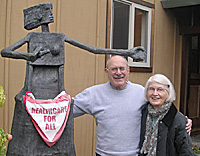On the Shabbat before Simchat Torah, at the weekly Torah study at North Seattle’s Temple Beth Am, Rabbi Beth Singer asked regular participants to share their favorite Torah verse.
Most offered stories from Genesis, a few noted the Exodus from Egypt while others singled out Moses’ final speech.
But sculptor Phillip Levine’s (say “vine,” not “veen”) favorite verses begin in Exodus 35, when the Israelites begin receiving directions for building the tabernacle. It starts with a description of “all these wondrous materials,” Levine observes, followed by an “extremely detailed process” of construction. Most fittingly, we read repeatedly in Lev. 36:1 of “every skilled person whom the Lord has endowed with skill and ability.”
Levine, who works mostly in bronze, has never spent much time trying to dissect where ideas come from. He’s the kind of guy who just wants to get to work — so Torah reflection is new to the 78-year-old artist.
“These are all late thoughts,” he says, adding that he and his wife Rachael only started going regularly to Torah study about four years ago, although they’ve belonged to the congregation since the early 1960s.
“I don’t think it’s made me more spiritual,” he observes, but says with age he has become more philosophical. “You realize you’re part of that context.”
This fits in with an insightful phase that began with putting together a book, Myth, Memory & Image: Sculpture and Drawings. The book was designed to complement a retrospective exhibit of his work that was mounted at the Museum of Northwest Art in La Conner this past spring.
“The book was a reflective process,” Levine says, and gave him the opportunity to think about his work in an objective way he hadn’t tried before. Published by the museum and distributed by University of Washington Press, it’s short on words and long on pictures, with photos of about 100 of the 700 to 800 sculptures he’s produced in his long working life.
“I don’t believe anyone knows what I’ve done in the larger sense,” he says of the overview.
Bronze sculpture comes to us through an industrial process, so it’s fitting that the Levines live in far-South Seattle. To get to their quiet neighborhood you need to pass through the city’s most industrial neighborhoods, flanked on the way by trucks of all sizes, with a view of factories, warehouses and scrap metal piles. His studio shares the lot with his home, but for a period of time he had a larger studio in South Park where he produced large commissioned works such as Triad, a piece for Martin Selig, which resides at 300 Elliott Avenue West in Seattle. “I love being close to [industry],” he says, noting that he owned a foundry for 25 years.
Born in Chicago, Levine grew up in Denver and went to the University of Colorado, expecting to study that most traditional of Jewish subjects, medicine. After two years he found himself unhappy with the subject and took a variety of courses, including one in three-dimensional design.
“I enjoyed working with my hands, ” he recalls, saying he was also “doing well in accounting,” but he just walked out of that class. Returning to school as a junior, he spent two years taking art classes, graduating with a degree in the subject.
After a brief time in New York, he and Rachael moved to Seattle so he could get a Master’s degree in sculpture and teaching at the University of Washington in 1961.
The couple raised three sons in the house where they still live.
“I raised them in the studio,” says Phillip, whose home studio allowed him to be a stay-at-home dad before that was in vogue. “That was wonderful.”
Josh and Aaron are now both artists and craftsmen in their own right. Phillip and Rachael’s youngest son Jacob was an artist, too, but also a pilot who died tragically in a plane crash when he was just 25.
Levine’s specialty is the figure, and particularly the figure in action. He was athletic and “doing sports and the awareness of what the body does and the pleasure of it was underlying much of the sculpture,” he says.
Norman Lundin, professor emeritus of art at the UW, states in an essay in Levine’s book that getting the human figure right is an enduring problem in Western art, but Levine “gets the gesture right.” You can see it in “Woman Dancing,” the sculpture on the East Capitol Campus in Olympia, or in “Leap,” the figures that spring down the steps of Spokane’s Veterans’ Arena. Tom Jay, the other contributor to Levine’s book, calls the sculptor “a midwife to wonder.”
These days, Levine works mostly on a smaller scale, making models that can easily be created in his studio. He uses what he calls a “lost carbon” method, creating a sculpture out of wood, cloth, paper, or other carbon-based material. A mold is built around the sculpture and the molten bronze is poured in, vaporizing the carbon-based materials. It’s a faster concept-to-sculpture process for the artist compared to the “lost wax” method, in which the creation of the sculpture and mold may take six months. He has also returned to oil painting after many decades.
“I didn’t paint for 45 years,” he remarks. Occasionally he opens up his studio to exhibit and sell his work, but he doesn’t show much in galleries now.
Levine now has more of the luxury of time, time to reflect, time to enjoy his four grandchildren and, of course, to continue creating.
“To do something well,” he says, “that has been my main focus.”
Sculptor looks back on life’s work
